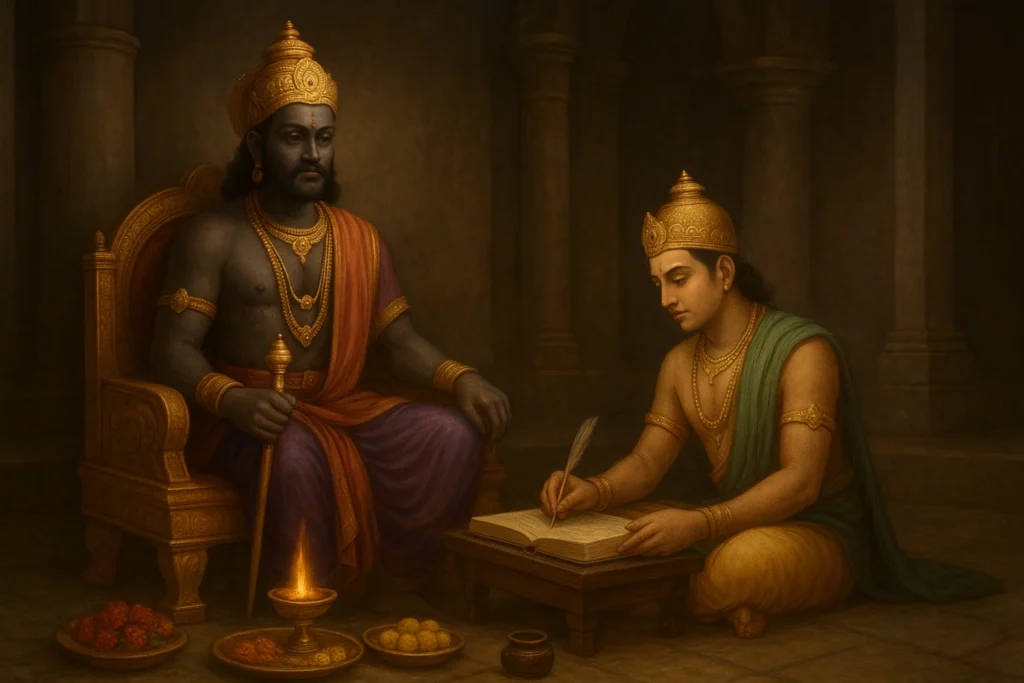This story explains why worship of Dharma-raj (Yamaraj) and Chitragupta became important in Hindu practice, and how a special fast (Vrata) on the bright second day (Dwitiya) of Kartika — and similarly observed in Chaitra — can free a person from sin and bring spiritual benefit. The account appears in Puranic narrations, where kings and sages seek guidance from elders like Bhishma and the gods to understand the right rites.

The Dialogue: Yudhisthira and Bhishma
In the Mahabharata tradition, Yudhisthira once asked his grandsire Bhishma to explain a virtuous vow and its fruits. Yudhisthira wanted to know which deity to worship on the Dwitiya (the second lunar day of the bright half of Kartika) and how to observe that vrata in Chaitra. Bhishma replied that hearing the related story alone can remove many sins, and then narrated the origin and function of Dharma-raj and Chitragupta.
Creation, Duties and the Origin of Chitragupta
Bhishma recounts the early cosmic story: in Satya-yuga, from the lotus at Lord Narayana’s navel, Brahma was born, and through him the Vedas and the order of creation came forth. Brahma, obeying the divine will, generated various beings — gods, gandharvas, demons, serpents, mountains, rivers, trees, and finally humans. To supervise the moral order and to assign karmic results fairly, Brahma appointed sages and made arrangements for the administration of dharma.
When the need arose for a precise recorder of human deeds (so that karmic rewards and punishments could be administered correctly), Brahma created a being especially for that task. This being — described as dark-complexioned, lotus-eyed and holding writing implements — identified himself as being born from Brahma’s thought. Brahma named him Kāyastha Chitragupta and placed him in service to Dharma-raj (Yama) to record the righteous and unrighteous acts of beings.
Chitragupta then undertook austere penance and devotion, worshipped fierce goddesses, and was blessed by the divine. He became the divine accountant who records every action of humans, ensuring justice after death.
The Story of King Saudasa (an Example of the Vrata’s Power)
Bhishma tells Yudhisthira the tale of a king — described in the text as a sinful ruler named Saudasa (a king of Saurashtra) — who led a life of adharma (wrongdoing). Toward the end of his life, the king observed seeing a Brahmin performing a vrata: the Brahmin was worshipping Chitragupta and Yamaraj devotedly during Kartika’s bright Dwitiya (and following prescribed rituals). Curious, the king attempted to undertake that same vrata himself.
Although the king had committed many sins, the story shows that by sincerely observing this vrata — performing worship, fasting, staying awake at night, offering appropriate materials (incense, sandal, flowers, lamps, food) and making charity — he did not deserve the worst punishment. On account of the vrata and the merits arising from worship, Chitragupta’s record was balanced in the king’s favor, and he was spared the severest fate. The tale emphasizes the powerful remedial effect of the Dwitiya vrata when observed with devotion.
Purpose and Significance of the Vrata
- The vrata is described as a powerful remedial rite that can mitigate the consequences of past misdeeds if practiced sincerely.
- It emphasizes remembrance of Dharma-raj and Chitragupta — the divine judge and his scribe — and appeals to the mercy and justice of the cosmic order.
- The practice underlines that ritual sincerity, charity, and disciplined observance can alter karmic outcomes.
- Hearing or reciting the story itself is said to cleanse many sins.
How to Observe the Dwitiya Vrata (Practical Steps from the Text)
Bhishma provides a practical outline for observing this vrata in a pious and effective manner:
- Choose an auspicious, clean place for the worship of Dharma-raj and Chitragupta. If possible place simple images or symbolic representations of both.
- Set up the altar with traditional puja materials: flowers, incense, sandal (chandan), lamps, fruits, sweets, cooked preparations (as available), and a lamp or diya. The text mentions offering many types of items (flowers, laddus, fruits, betel leaves, and other traditional offerings).
- Offer respectful salutations repeatedly to Dharma-raj and to Chitragupta, invoking their blessings: “Namaskar Dharma-raj” and “Namaskar Chitraguptaji.”
- Include symbolic items for Chitragupta — especially a dawat (inkpot) and a kalam (pen), since Chitragupta is the divine recorder. Worship these tools as sacred.
- Recite the story or listen to the related kathā (narration). The text says that listening to the tale purifies the listener.
- Observe a fast (vrata) on that day — abstain from regular meals or take light fare as tradition permits.
- Stay awake in the night (jagaran) before dawn and engage in devotional singing or recitation if possible.
- Perform charity (daan) — give food, clothing or money to dependents, Brahmins, the sister’s household (as the text recommends giving to one’s sister or kin), or the needy.
- After worship, partake in a simple meal with family and distribute prasad and offerings to relatives; treating family and feeding them is part of the ritual completion.
- Conclude with prayer and resolve to observe dharma and ethical conduct.
When observed sincerely and with charity, the vrata is said to bestow the desired fruits and protect the observant from severe afterlife punishments.
Ritual Emphases and Symbols
- Chitragupta’s pen and ink: symbolic of the karmic account; these are to be treated with reverence during the puja.
- Facing and positioning: the story suggests reverence and correct placement, but local customs may govern orientation.
- Night vigil (jagaran) and charity (daan) are central: ritual devotion combined with compassionate action is emphasized repeatedly.
Spiritual Message
Beyond ritual efficacy, the tale underlines a moral teaching: even one who has committed many wrongs can gain redemption through heartfelt penitence, disciplined practice, devotion, and generosity. The presence of Chitragupta as the recorder of deeds underscores the moral seriousness of every action; yet the vrata shows that grace and corrective practices exist within the dharmic tradition.
Conclusion
The Dwitiya vrata dedicated to Dharma-raj and Chitragupta is a potent blend of ritual, narrative and ethical instruction. It affirms that the cosmos keeps account, but it also offers a path of remedy — through sincere worship, fasting, night vigil, charity and story-listening — that can reshape a person’s karmic record. Observance of this vrata cultivates responsibility, discipline and compassion.
Frequently Asked Questions (FAQs)
1. Who is Chitragupta?
Chitragupta is the divine scribe created by Brahma to record the actions of all beings. He assists Dharma-raj (Yama) in the administration of karmic justice.
2. What is the Dwitiya vrata mentioned in the story?
The Dwitiya vrata is a vow observed on the bright second day (Dwitiya) of the lunar fortnight — traditionally noted in Kartika (and referenced in Chaitra) — involving worship of Dharma-raj and Chitragupta, fasting, night vigil, listening to the kathā and giving charity.
3. Why does the story include King Saudasa (or the sinful king)?
The tale of the sinful king illustrates the remedial power of sincere vrata practice: despite many sins, a devoted observance of this vrata, combined with charity and night vigil, can grant relief from severe punishment.
4. What are the essential items for Chitragupta puja?
Basic items include flowers, incense, lamps, fruits and cooked offerings. Special symbolic items for Chitragupta are an inkpot (dawat) and a pen (kalam), which are worshipped as representations of his role.
5. Do I need a temple to perform this vrata?
No. The vrata can be performed at home in a clean, dedicated space. Using simple images or symbolic representations of Dharma-raj and Chitragupta suffices when temple access is not possible.
6. Is listening to the kathā (story) important?
Yes. According to the tradition recorded in the narration, hearing the story itself cleanses many sins and is a key component of the vrata’s efficacy.
7. How do I find the correct date for the Dwitiya vrat this year?
The Dwitiya referred to here is a lunar tithi (bright second). Tithi dates vary by region and the local panchang. Check a reliable panchang (DrikPanchang, local temple calendar, or regional almanac) set to your city to confirm the exact Gregorian calendar date for Kartika Shukla Dwitiya or Chaitra Shukla Dwitiya in a given year.





